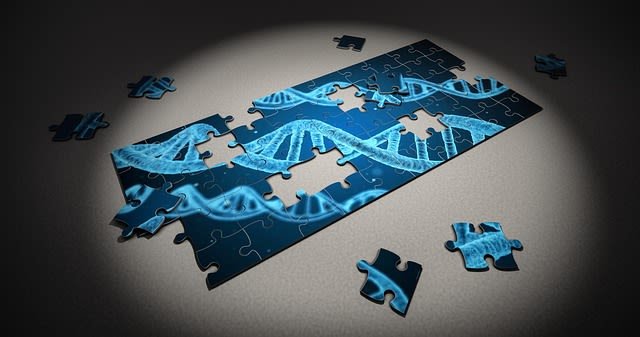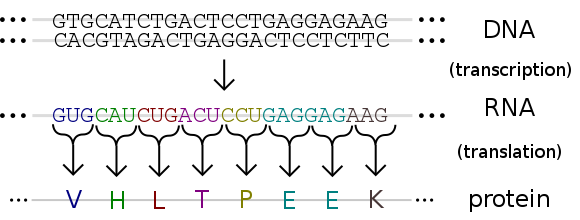THE SCIENCE OF GENETICS
Do you
share genes with a purple sea urchin?source
In the first decade of the twenty-first century, the complete genomes of humans and many other animals have been sequenced. This has led to some interesting comparisons. It will probably come as no surprise that 98.7 per cent of your basic genome is shared with the chimpanzee, as apes are the closest living relatives of humans. It may come as a bit more of a shock that the purple sea urchin is also a close relative. About 70 per cent of sea urchin genes correspond to human genes and sequencing its genome has turned up a few other surprises.
This simple organism turns out to have a very advanced immune system, it is born able to recognize bacteria and viruses and fight them off. This is something that the human immune system has to learn and often needs help from vaccines to manage effectively. The sea urchin, which has no ears or eyes, was thought to be completely blind – but its collection of visual perception genes suggests otherwise. Sea urchins also have genes associated with muscular dystrophy and Huntington’s disease, which are both important human genetic diseases. Research is now going on to use the sea urchin as a genetic toolbox to find out more about these diseases and to potentially develop new drugs to be able to treat them.source

SO, WHAT ARE GENES?
Genes are the ‘instructions’ that control everything that happens inside a cell. Physically, genes are different sized stretches of DNA that code for the manufacture of proteins such as enzymes. Enzymes organize the chemistry that goes on in our bodies and are behind all the life processes, including growth, repair and reproduction. Throughout our lives, the genes remain in the nuclei, directing the activities of each of our cells.source
Children grow and develop according to the genes they have inherited from their parents. It’s a harsh fact, but nothing lives forever: the inevitable fate of all organisms, often sooner rather than later, is death. However, although we die, our genes can live on in our offspring.
In the 2005 movie titled “The Island”, a society was depicted in which human clones are bred to provide spare parts for their original human counterparts.source I guess this is already happening, lol?
STUDYING GENETICS
Studying genetics means learning about DNA and what it does. In this lengthy article, we divide our study of this remarkable molecule into five areas:source
- The cell cycle is the study of how cells divide. Discovering just how a single fertilized egg can develop into an organism as complex as a human is one of the central challenges of biology. When the control of cell division goes wrong, it can lead to cancer.
- Molecular biology is the branch of science that deals with all aspects of the DNA molecule: its structure and function. How are genes used to make products? Why are some genes active when others aren’t? How can DNA copy itself? How do mutations occur?
- Genetics is the study of inheritance: the way in which genetic information is passed on from one generation to the next. Why are only some genes passed on? Why are some characteristics always shown while others are hidden?
- Evolution looks at how species change and develop with time. What is the mechanism of this change? How long does the process take? Can we observe evolution in action? What do we know about the evolution of humans?
- Genetic engineering is the popular name for the technology that manipulates the DNA molecule. How can we change DNA? How can we transfer DNA between organisms? What are the benefits of genetic engineering? Can we cure genetic disease? Should we pursue this technology at all?source
THE POTENTIAL OF GENETICS
Few scientific subjects make the headlines as often as advances in genetics technology. We are witnessing an accelerating revolution that is likely to have far-reaching effects. We know what the complete set of human chromosomes looks like. We have also mapped the complete human genome and are now embarking on the daunting task of finding out where the genes are, what they do and how they interact with each other. We may have the ‘book of humans’, but it’s huge and written in a foreign language.
The implications of this progress are enormous:
- Two out of every three people die for reasons connected to their genes. Although only a small percentage inherit a lethal genetic disease, many more inherit a tendency to develop a condition such as heart disease, premature senility or cancer. We call this a genetic predisposition. An in-depth knowledge of the human genome will make it possible for doctors to screen babies before or soon after birth for genetic abnormalities and tendencies to develop such diseases. But this raises ethical and moral questions, not just scientific ones: would you want to know just how likely you are to develop cancer in middle age? Would you want anyone else to know – life insurance companies, potential employers, friends or partners? Who would have access to your DNA files?
- We can isolate genes for useful products, such as insulin and growth hormone, and place those genes into another organism. This is recombinant DNA technology. Bacteria already produce human insulin and other products on a large industrial scale, and it is also possible to transfer such genes into higher animals, for example, sheeps so that they produce millk containing the required protein.
- We can isolate faulty genes, such as those which cause cystic fibrosis, and replace them with multiple copies of healthy genes. Although still at the experimental stage, this gene therapy holds much promise for the future.
- We could be able to halt some of the genetic causes of ageing, and allow more people to live even longer.source
Only the bravest scientists would dare to speculate about where our genetic knowledge might eventually take us. It could be to a greatly improved world where suffering is reduced while quality of life and life expectancy are improved. Genetic engineering and agricultural techniques might give us food-producing species that can live in the harshest of conditions, so providing food in areas of most need.
But can we be this optimistic? There are still many things we don’t know about living organisms and it is impossible to predict exactly the effects of interfering with an organism’s DNA. Already, companies are trying to patent genetic material and its products, leading to hot debate about whether or not such natural products can be owned, like a brand name or an invention. Will genetic advances be used solely to make money, and therefore be available only to those who can pay?

Genes are expressed by being transcribed into RNA, and this RNA then translated into protein.
Madprime - Own work, CC BY-SA 3.0
The ethical implications of some very recent developments also need to be considered. The first mammals have now been cloned but the process is unreliable. This has led to a heated debate about whether it’s ethically right to clone humans.
WHAT GOES ON IN THE NUCLEUS?
The nucleus of every human cell contains DNA. Each nucleus contains a set number of long, elaborately coiled DNA molecules that condense into chromosomes. Genes, the individual instructions, are dotted along the chromosomes.
In an adult organism, most cells are not dividing: the chromosomes are uncoiled, and active genes are producing proteins to control the activities of the cells. Not all genes are active at the same time: controlling which genes are active and which are not enables different cells to carry out different actions. For instance, all cells in the human body contain two copies of the insulin gene. Only in certain specialized cells in the pancreas, however, are the genes switched on and used to make insulin.source
GLOSSARY OF GENETICS TERMS
Like many branches of science, genetics comes with its own vocabulary, seemingly designed to make some very straightforward ideas inaccessible to the average person. You will need to know the following terms:source
Diploid: cells or organisms containing two sets of genes. Human body cells, for instance, are all diploid.
Haploid: cells or organisms containing one set of genes. Human sex cells (egg cells and sperm) are haploid.
Gene: a length of DNA that codes for a particular polypeptide. Some proteins consist of more than one polypeptide; these are coded for by more than one gene.
Allele: one form of a gene. There may be two or more alleles of any particular gene. Diploid organisms contain two alleles, one on each pair of chromosomes. For example, in pea plants, the gene for flower colour may have a red allele and a white allele.
Genotype: the genetic make-up of an individual.
Phenotype: the observable characteristics an organism possesses. For example, in peas, the genotype Aa may result in a phenotype of red flowers. Many alleles are expressed, or used, and these contribute to the characteristics of the individual. Other genes – recessive alleles in the presence of a dominant version – are not expressed and so remain hidden.
Dominant: the allele that, if present, is expressed. If the red allele in the pea plant is dominant, the pea has a red flower, even if it has a white allele as well.
Recessive: the allele that is expressed only in the absence of the dominant. In the pea, if the white allele is recessive, the plant has white flowers only if it has two white alleles.
Homozygous: when both alleles of a particular gene are the same. In the pea example, an individual would be homozygous if it had two red alleles or two white alleles. We usually give letters to denote alleles, for example A for the dominant allele and a for the recessive allele. Individuals with genotype AA or aa are homozygous.
Heterozygous: the two alleles of a gene are different. In a pea plant, a heterozygous individual could have a red allele and a white allele, so their genotype would be shown as Aa.

Mice with different coat colors. FloNight on en.wikipedia, Public Domain.
VARIATION: WHY IS EVERYBODY DIFFERENT?
The group of people in the picture below shows what we all know: that everyone is different. Height, weight, intelligence, personality, eye colour, size of feet – the list is endless. No two people have the same combination of features. Even identical twins show subtle differences. So what makes us the way we are?
Each human baby is born with a unique set of genes – we call this its genotype. However, only one of these genes affect the observable characteristics of the organism – its phenotype. Recessive genes, for example. Remain hidden, masked by dominant versions. The other factor that contributes to the phenotype is the environment – the circumstances in which the organism grows affect the way in which genes are expressed.source
INTERSPECIFIC AND INTRASPECIFIC VARIATION
As you saw at the start of the chapter. Humans and chimps have 98.7 per cent of their genome in common. This difference, just in the actual structure and sequence of the genes, is called interspecific variation. This variation in the genome between species is often very low when species are closely related in evolutionary terms. However, as you know, chimps and humans are not identical, and they don’t behave in the same way. So what accounts for this apparent anomaly?
The answer is gene expression. There are millions of different ways in which the same thousand genes can be expressed, turned off and interact with each other. Genes in humans are expressed very differently from the corresponding genes in the chimp. Different members of the same species can also show big differences in the way they express the same genes. This is why there are such big differences between individuals. Biologists use the term intraspecific variation to describe the differences in gene expression that occur between members of the same species.source

Group of students in a photograph. Basile Morin - Own work, CC BY-SA 4.0
WHY IS VARIATION NECESSARY?
Variation in a population has great survival value because it greatly increases the chance that at least some individuals will adapt to changing conditions. To illustrate this, consider a clone, a population of genetically identical individuals. All is well when conditions are favourable, but when a serious disease comes along it is very likely that all of the organisms in the population will die. In a more varied population that has developed as a result of sexual reproduction and variation, there is a much greater chance that some of the individuals could be resistant to the disease. These individuals survive to breed, ensuring that the population, and perhaps the whole species, continues.source
HOW VARIATION OCCURS
Variation arises because individual genes mutate. Mutations are changes in genetic material of an organism, often caused by faults in the copying of the DNA. Once there is some variation to work on, the differences are maximized by the process of sexual reproduction. Using humans as an example we can see how this happens.
First, gametes are produced by meiosis. This is a special type of cell division which not only produces haploid cells, but shuffles the genes so that all eggs or sperm made by a particular individual are different. In meiosis, there are two key events that produce variation:
- Crossover during prophase I. Blocks of genes are swapped between chromosome pairs. Bringing some new genes together and separating others.
- Independent assortment during anaphase I. Either chromosome from each pair can pass into the gamete. As a human cell has 23 pairs of chromosomes. 223 different combinations are possible.
Secondly, following meiosis, fertilization joins gametes from two separate individuals to form a genetically unique zygote from which the new diploid organism develops.source
Continuous and discontinuous variation
There are two main types of variation in a population: continuous variation and discontinuous variation.
- Continuous variation is so-called because the factors or variables, can be any value inside a given range. Examples of continuously varying characteristics include height and weight in humans, and the number of leaves in plants, length of bones, human fingerprints, tolerance to adverse conditions, such as cold, heat, dehydration, etc.
- Discontinuously varying features do not display a range: they are either one thing or the other. They are more often qualitative (you can describe it, but not measure it). The ABO human blood group system is a classic example of discontinuous variation: people are either A, B, AB or O.They cannot be anything in between. Height in pea plants is another example: pea plants can be either tall or dwarf. Also is the ability to roll tongue in humans, and ability to taste phenylthiourea, etc.source
I will like to stop here for now. Hope you enjoyed the write-up.
Thanks for reading.
REFERENCES
https://study.com/academy/lesson/continuous-discontinuous-variation-in-a-species.html
https://study.com/academy/lesson/continuous-discontinuous-variation-in-a-species.html
https://courses.lumenlearning.com/boundless-biology/chapter/population-genetics/
https://www.britannica.com/science/variation-biology
https://compbio.imascientist.org.uk/question/why-is-everyones-dna-different/
www2.palomar.edu/anthro/mendel/glossary.htm
https://en.wikipedia.org/wiki/Cell_nucleus
https://www.sciencedirect.com/science/article/pii/S0924977X13000710
https://en.wikipedia.org/wiki/Genetics
https://www.nigms.nih.gov/education/pages/factsheet_studyinggenes.aspx
This post has been voted on by the SteemSTEM curation team and voting trail. It is elligible for support from @curie.
If you appreciate the work we are doing, then consider supporting our witness stem.witness. Additional witness support to the curie witness would be appreciated as well.
For additional information please join us on the SteemSTEM discord and to get to know the rest of the community!
Thanks for having added @steemstem as a beneficiary to your post. This granted you a stronger support from SteemSTEM.
Thanks for having used the steemstem.io app. You got a stronger support!
Aren’t we also close relatives to pigs?
In short, even beings with 99.9% genes in common could be quite different, as each gene can express itself very differently. Is that correct? Is there a way to evaluated the common ground of the genome between two species when accounting for the potentially different gene expressions?
Evolution has answered all the questions that might pop up. Since it's been agreed that we all came from a common ancestor, why should it then be a surprise that we share similar genes with other animals?
We may have a common basis, but 9x% is a high level, isn't it?
That's definitely understandable with apes but sea urchins? Unless there is a connecting links
We need to say the paths from one to the other I guess. But this is way beyond my zone of comfort ;)
It is called 'adaptive radiation'. While humans and apes share the same route of adaptive radiation, sea urchins have a completely different route but since we all shared a common ancestor, I am not surprised their genes is 70% similar to that of humans. If the genes of all living organisms are sequenced, I am sure we will discover a similar trend as far as the theory of organic evolution stays true.
Yes, that's correct.
Thanks for these useful details! :)
Sure, we are closely related to pigs. Also cos of the fact that we are both mammals means that we share some genes which is at least 98 per cent. This link would help.